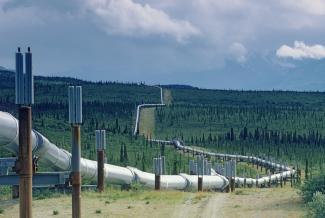
Last week, the Alberta Appeals Court ruled that the federal government’s environmental Impact Assessment Act was an overreach of federal powers and posed an “existential threat” to the division of powers guaranteed in the constitution.
The federal government has announced its intention to appeal that ruling at the Supreme Court of Canada.
The act is an important tool for upholding the rights of Indigenous peoples and mitigating the environmental impacts of natural resource projects like pipelines, according to Temitope Onifade, a doctoral student at Allard Law and Affiliated Research Scholar at the Canada Climate Law Initiative. Here, he explains why it’s worth keeping an eye on the federal government's Supreme Court appeal.

What does the Impact Assessment Act enable the federal government to do? How important is it?
Without this law, each province remains in charge of its natural resource projects, energy projects, and oil and gas projects — and their impacts.
What this law does is allow the federal government to regulate the impacts of these projects, in cases where they impact areas that are under the federal government’s jurisdiction — that includes fisheries, marine areas, and international and national climate policy. It also includes Indigenous lands and areas where Indigenous communities use natural resources.
This case is important because it addresses the usual clash of constitutional power between federal and provincial governments regarding who should have a say on the regulation of environmental impacts, especially during this period of climate emergency.
The Federal Justice Minister and the Environment Minister note that the Alberta Court’s opinion is advisory and that the Impact Assessment Act and regulations remain in force. Is the Alberta court’s decision in any way binding?
The status quo will remain for now. This is a ‘reference case’ — the Government of Alberta referred the question of whether or not this law goes beyond the constitutional law-making powers of the Federal Government to the Alberta Court of Appeal for its opinion.
Basically, the Alberta government is saying, ‘let us know if this is right or wrong.’ In practice, the government will usually go with the court’s decision — even though it is advisory and not legally binding. This is a unique aspect of Canadian law.
How strong is the federal government’s case?
I think the Supreme Court may uphold this impact assessment legislation. Even though this is not technically a climate law, the realities of climate change justify the federal government’s attempts to regulate those impacts. If you read the Alberta Court’s judgment, all the judges agree that climate change is an existential threat. I think the Supreme Court judges are going to be influenced by that fact.
In a recent case, the Supreme Court ruled that, to curb emissions contribution to climate change, parliament did have the power to create the carbon pricing law, in spite of provincial jurisdiction. That decision was based on a provision in the constitution that says the federal government can pass laws in areas of provincial jurisdiction that concern ‘Peace, Order and Good Government’ of Canada, often called the national concern doctrine. The Supreme Court will have to consider that, as the impact assessment process is of national concern for taking adequate action on climate change.
Natural resource projects impact the rights of Indigenous peoples and the climate. This appeal is going to say a lot about the direction of Canada in responding to both these issues.
They will likewise have to consider the rights of Indigenous peoples. We have a renewed sense of Indigenous rights in Canada, and judges have to consider Indigenous rights that are already enshrined in Canadian law, including the right to consultation. A lot of natural resource projects are going to impact Indigenous lands and Indigenous peoples have treaty rights guaranteed by the Constitution and participation rights guaranteed by other laws.
These changing times might be what makes the difference in this case. Yes, the federal government is overreaching into provincial jurisdiction. But why is it doing that? Out of necessity.
Why is this an important case to watch?
Natural resource projects impact the rights of Indigenous peoples and the climate. This appeal is going to say a lot about the direction of Canada in responding to both these issues.
If the federal government's appeal is not successful, that would be a big deal because it would mean that these natural resource projects will continue to have huge impacts. The Government of Canada will have less control, and this will undermine climate legislation and international policy commitments.
Of course, if the Supreme Court Appeal is not successful, the federal government will try to find other ways to regulate the impacts of these projects. Maybe that will be through economic regulation — holding back on some federal government incentives to provinces, increasing national carbon prices that would impact them, or doing other things to affect market competition. The law comes down to who is more creative.

